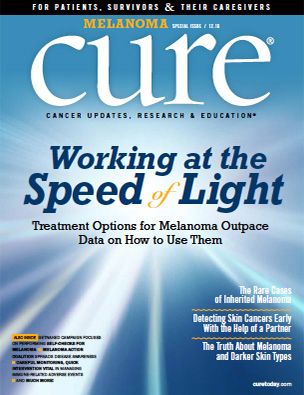Publication
Article
CURE
In Watching for the Side Effects of Immunotherapy, You are Your Own First Line of Defense
Author(s):
WITH THREE “CHECKPOINT-INHIBITING” IMMUNOTHERAPIES NOW FDA-approved for the treatment of melanoma, we all need to be attuned to the unique grouping of side effects that can arise when patients take these medications.
WITH THREE “CHECKPOINT-INHIBITING” IMMUNOTHERAPIES NOW FDA-approved for the treatment of melanoma, we all need to be attuned to the unique grouping of side effects that can arise when patients take these medications.
It’s not a concern you need to dwell on if you haven’t experienced side effects that get in the way of your everyday life, but it’s something that you and your health care team should be aware of. In this special issue of CURE®, we address the topic in an interview with medical oncologist Dr. Jeffrey Weber, who outlines the common and less common — but more potentially dangerous — side effects of these drugs. These drugs are relatively new, but in an unprecedented manner are rapidly expanding in use across many tumor types — faster than our ability to accurately quantify and characterize their side effects.
The approved immunotherapies for melanoma fall into the category of checkpoint inhibitors, which target certain proteins that are involved in keeping the immune system from going into overdrive. By releasing these “brakes,” the medications allow the immune system to gain power to fight the cancer. These drugs represent an incredible scientific breakthrough in the treatment of melanoma and many other cancers, but they can cause side effects, primarily due to immune activation working against normal tissue in addition to the intended cancer targets.
Typically, the immunotherapies Keytruda (pembrolizumab), Opdivo (nivolumab) and Yervoy (ipilimumab) do not cause discomfort as severe as that often sparked by systemic drugs like chemotherapies. But their side effects do have a unique and recognizable pattern. The most common are fatigue, fever and rash or itchiness. Swelling of the lymph nodes can also occur, which is not unexpected unless it’s focused in one specific area, which could indicate disease relapse. Inflammation of the lining of the gastrointestinal tract can lead to diarrhea. Check with your oncology nurse about any palliative therapies that could decrease the severity of these side effects and make you more comfortable.
Some symptoms may only be noticed by your doctor in lab tests: liver inflammation, kidney inflammation, elevated pancreatic functions or decreased functioning of the thyroid gland.
And then there are a group of more concerning symptoms. A much more serious incarnation of the typical immunotherapy rash can be a shedding of skin, which can invite bacterial infection and become lifethreatening. Other less common but potentially fatal side effects can include shortness of breath, which can signal lung inflammation, and an inflammation of the colon. Additional signs of potential danger are neurological symptoms, such as weakness in the extremities, memory loss or severe headache.
Most often, side effects can be handled with steroids or by delaying a dose of immunotherapy, in many cases temporarily. Although you may have reservations about reporting any side effects that could lead to an interruption in your treatment, your safety must be your primary concern. It’s up to you and your caregivers to contact your doctor or oncology nurse if you are having side effects from immunotherapy drugs that seem potentially serious, before they escalate into the danger zone. You are your own first line of defense when it comes to ensuring that your anticancer regimens are helping you — without causing serious and avoidable damage.





